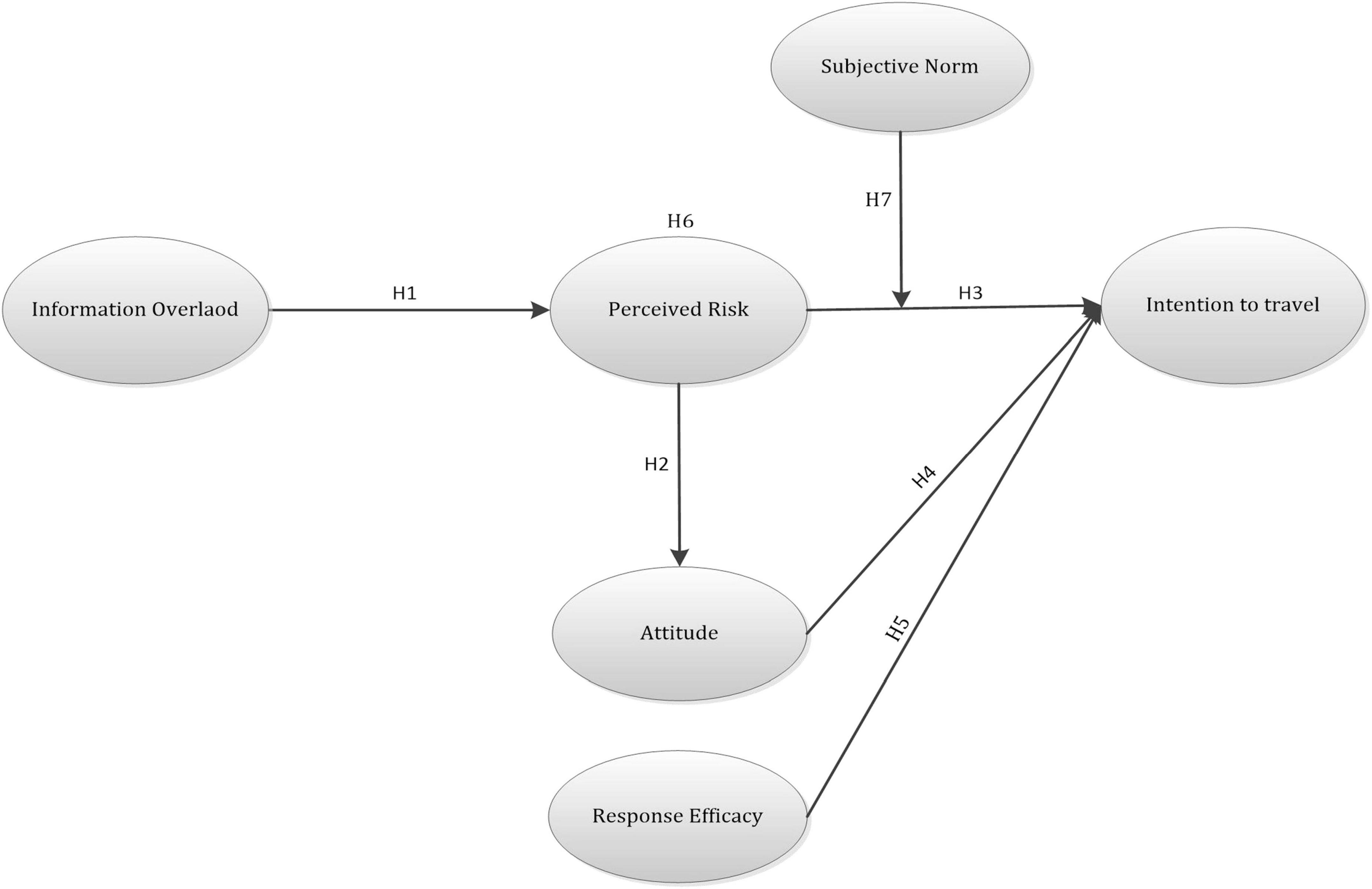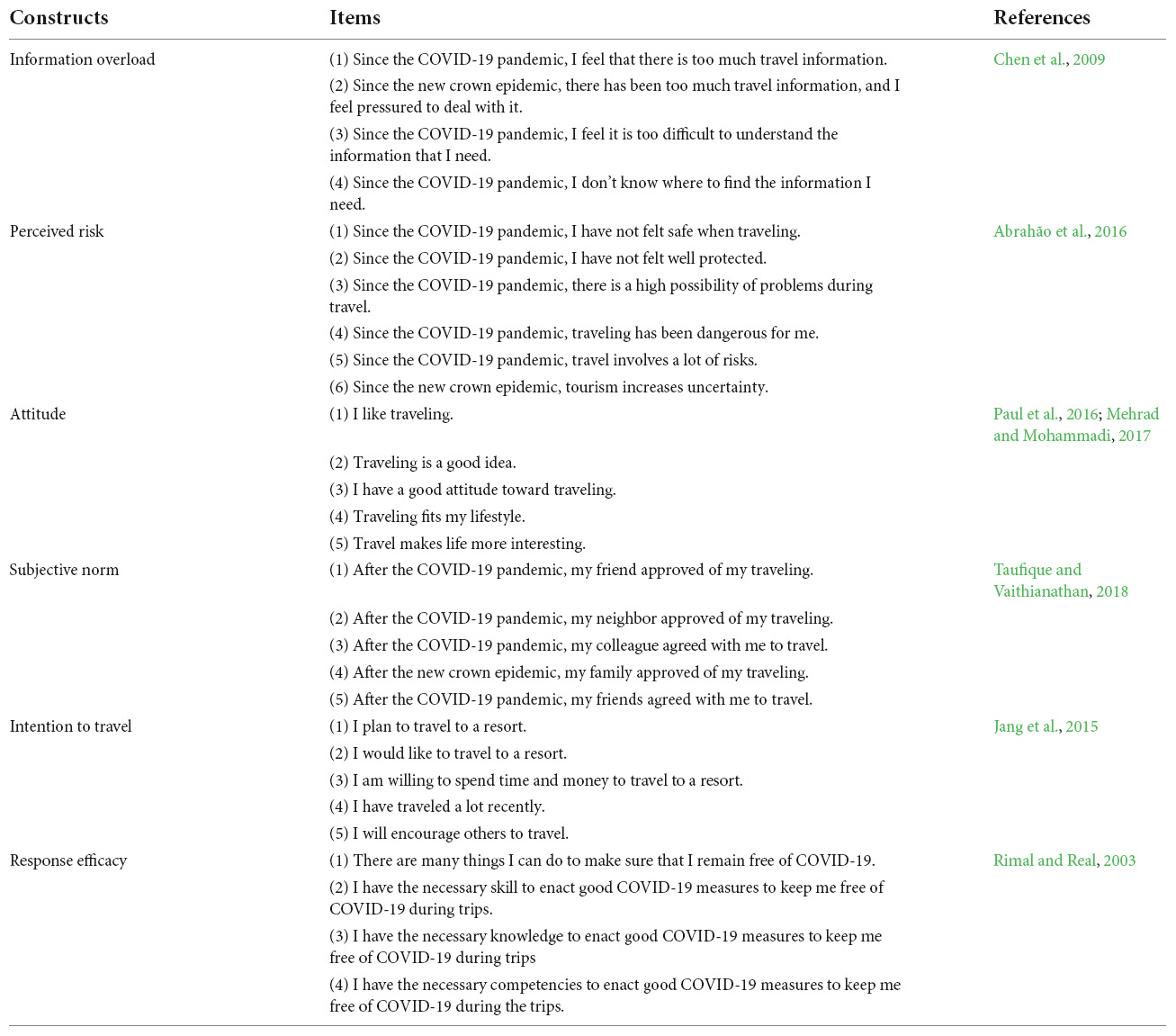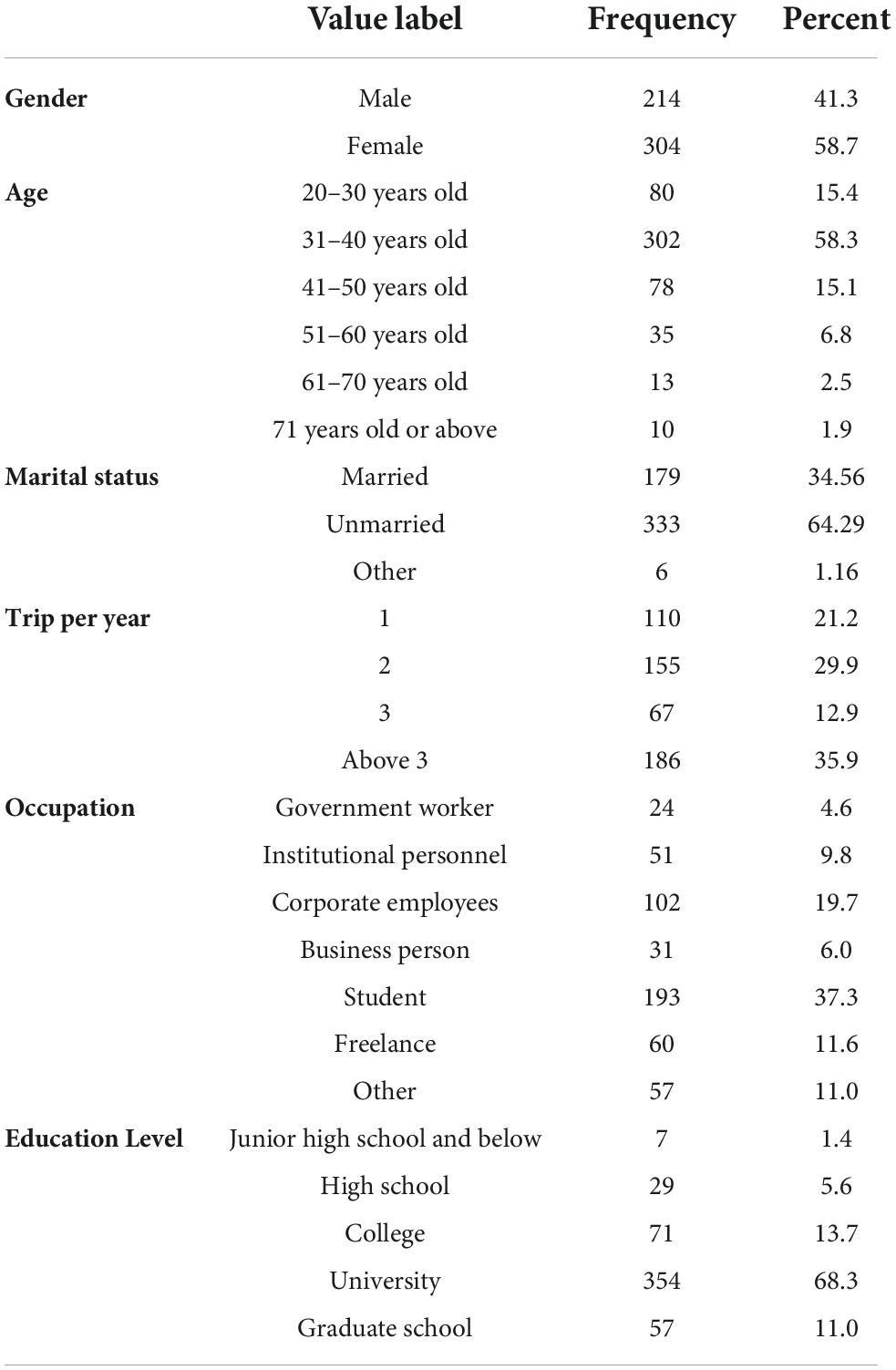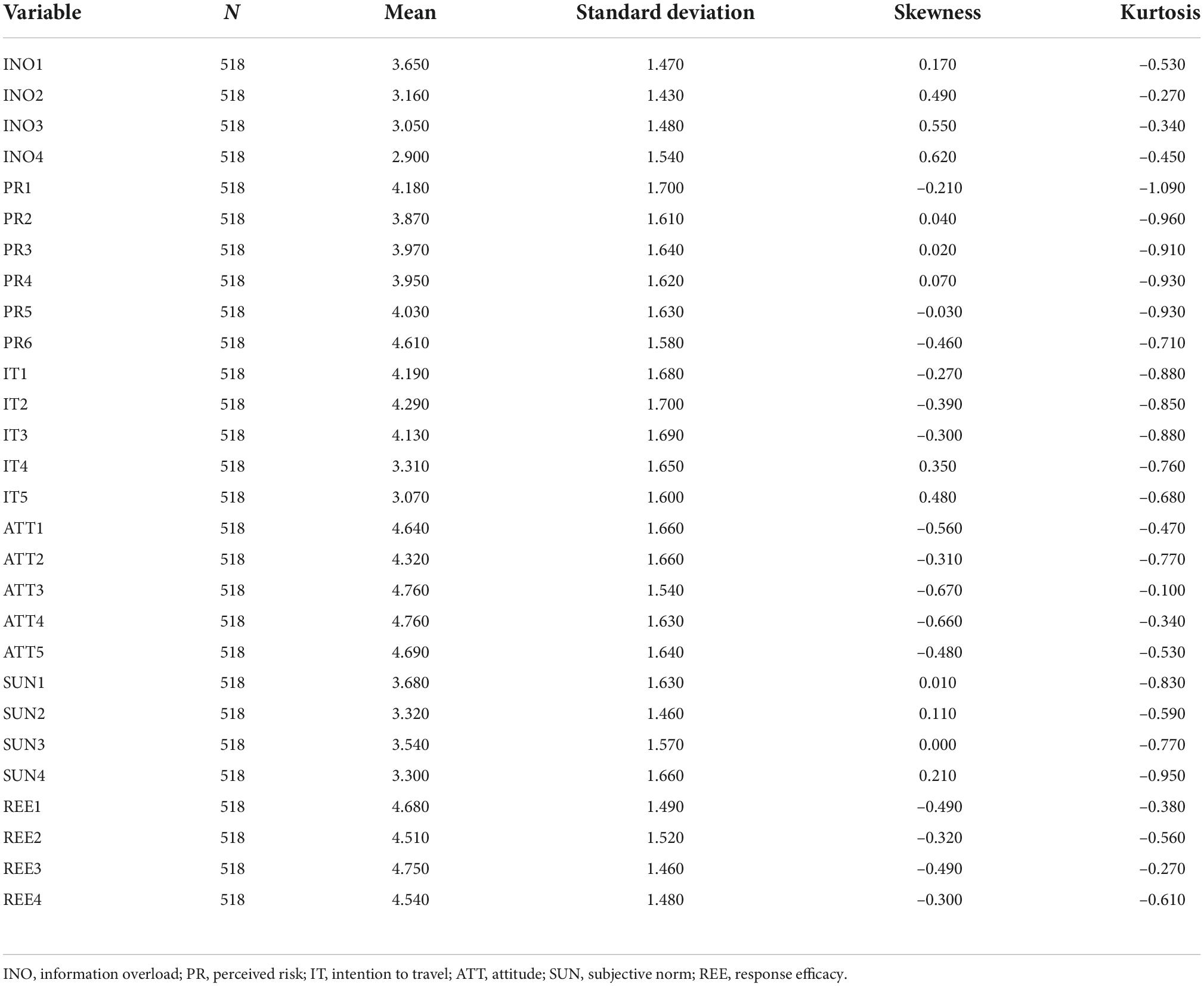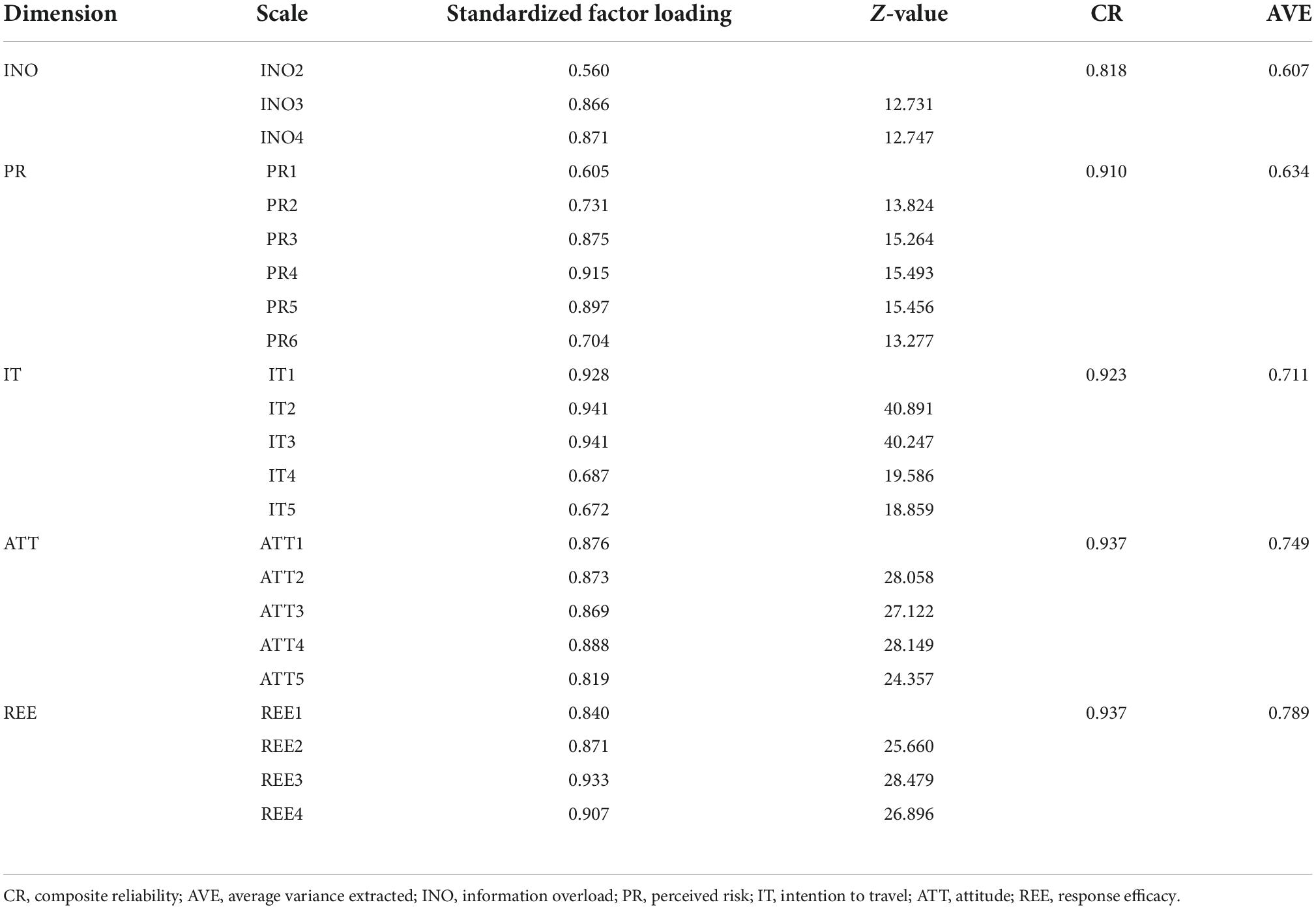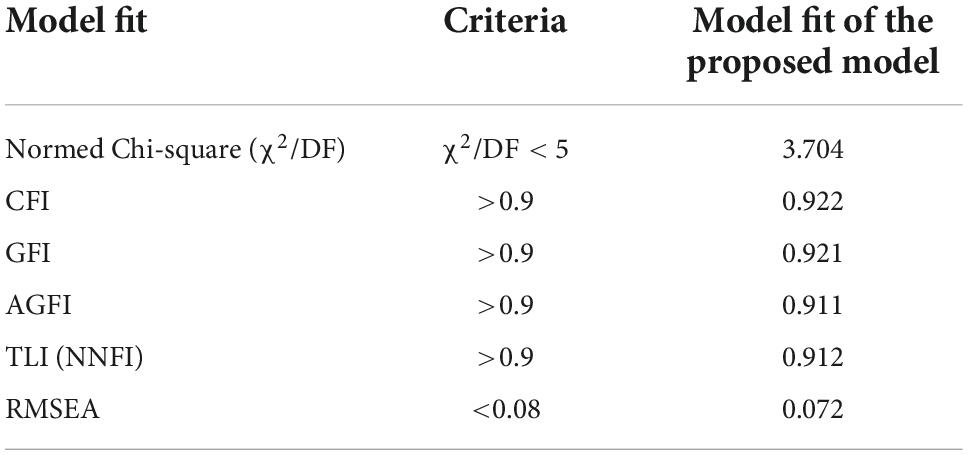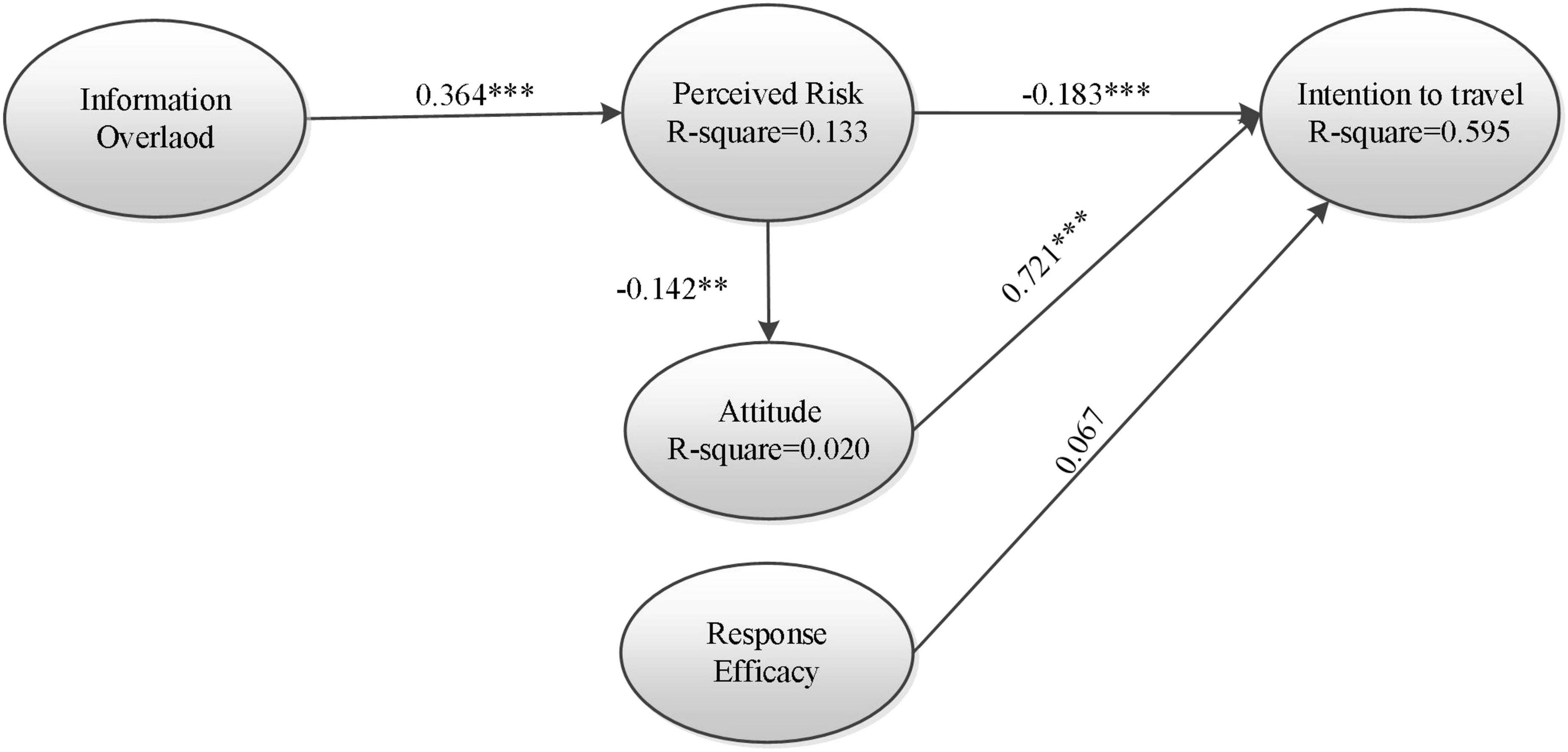- 1School of Tourism, Hainan University, Haikou, China
- 2School of Humanities and Social Science, Hong Kong University of Science and Technology, Kowloon, Hong Kong SAR, China
- 3College of Humanities, Hainan University, Haikou, China
- 4Quantitative Analysis and Research Association, Kaohsiung, Taiwan
Since the COVID-19 pandemic, the tourism economy has been seriously affected. China has implemented a direct traveling management mechanism and recovered from the pandemic faster than the rest of the world. However, the COVID-19 situation is complicated and uncontrollable because of the available unclear information including difficult medical terminologies. This study attempts to find the determinants of the travel intention of China’s tourists in the post-COVID-19 epidemic. Along with information overload and perception risk, an expanded research model of the Theory of Planned Behavior (TPB) was employed to propose the theoretical framework of this study. A survey was conducted among 518 tourists who spend their holiday in Hainan, which is a popular tourist destination in China. The empirical results show that information overload positively and significantly impacted perceived risk. Furthermore, perceived risk negatively affects the intention to travel. Perceived risk also negatively affected the attitude toward traveling. However, response self-efficacy did not have a significant effect on the intention to travel. Finally, based on the analysis results, this study proposes relevant research contributions and practical recommendations with management implications for the travel industries.
Introduction
Currently, various industries faced issues during the COVID-19 pandemic. However, tourism is deemed to be one of the most seriously impacted industries. The subsequent changing behaviors of tourists in the post-COVID landscape are worthy of attention to many researchers. De Vos (2020) discussed the potential effects of avoiding social contact and reduced interaction under measures to combat the spread of COVID-19. Furthermore, social distancing and restricted traveling result in social isolation and limited activity. In addition, Brooks et al. (2020) illustrated the psychological impact of quarantine and concluded that it has several negative psychological effects. The study recommended defining a clear rationale and information for quarantine and ensuring sufficient supplies. Neuburger and Egger (2020) determined the relationship between the perception of travel risk and the travel behavior of travelers during the COVID-19 pandemic.
Moreover, there is adequate information available regarding COVID-19, including views on virus mutation and vaccination development on the internet. Mutant viruses, such as Alpha, Beta, Gamma, and Delta, have been discovered among various COVID-19 patients (Jason Gale, 2021). The COVID-19 pandemic has brought a series of new challenges in terms of information overload (Rathore and Farooq, 2020). The COVID-19 pandemic has caused disorder in various areas. For instance, vaccines that were developed in many countries are being used but the unknown nature of the pandemic means that it is difficult to predict future trends. Additionally, the information about the pandemic is also complicated and diverse so it is often contradictory. Also, there is an overloaded and chaotic information flow for the general population. This negates the effect of measures to control the spread of COVID-19 infections (Mohammed et al., 2021).
Hainan is the southernmost island in China and has been a popular tourist destination in China for many years. China tourists visit Hainan for its warm climate, beaches, and palm trees. In recent years, it has become an international business conference and exhibition center. In the post-COVID-19 era, Hainan’s tourism industry has also been significantly affected.
After the COVID-19 pandemic, on January 24, 2020, the government of Hainan began a community wellbeing emergency response and encouraged the scale response of community wellbeing emergencies on January 25, 2020. This implies that past January 24th, 2020, the inner movement of individuals was significantly contained, and Hainan nearly did not have any tourists for a section of the period in January. However, owing to efficient community supervision and health care, the pandemic in China was effectively controlled, and the people’s movement started to continue in an organized way (Liu et al., 2021).
This study surveys travelers of Hainan in the post-COVID-19 era to determine the effect of information overload, perceived risk, attitude, and response efficacy on intention to travel. The research study also employs subjective norms as a moderating variable to determine the effect of public opinions on the relationship between perceived risk and intention to travel. Furthermore, the theoretical framework of this study was built on theories and concepts related to consumer behavior, information overload, perception risk, and an expanded research model of the Theory of Planned Behavior (TPB). The results of the study examine the effect of information overload on the intention to travel and the importance of correct and useful information in the post-COVID-19 era.
Theoretical background
Information overload
Miller (1956) first proposed the concept of information overload, which means that at any given time, through psychological research, the processing power of humans is very limited. The maximum amount of information that can consciously be processed is about seven units. Consumer decision-making was later studied by Jacoby et al. (1974) to define the theory of information overload. Furthermore, Matthes et al. (2020) noted that overburdening with information, permanent online interaction with other users, the perception of permanent observation, and demand for reactions result in information overload for mobile social networking sites (SNS) use.
Information overload refers to a state whereby a person believes that there is an imbalance between environmental needs and the available resources that can be used to respond to these needs (Eppler and Mengis, 2004). Other academic disciplines, such as cognitive psychology, focus on the acute phenomenon of information overload, which affects recall, judgment, and decision-making (Bargh and Thein, 1985). Fu et al. (2020) noted that overloading describes a person’s subjective perception and evaluation of the amount of information, persons, or objects that exceed the processing capacity. In an era of information and communication technologies, overload is a key factor in providing negative results (Lee et al., 2016). Various devices and applications can increase personal perceptual overload (Yin et al., 2018).
At the beginning of the COVID-19 epidemic, inaccurate information and information overload caused consumers to engage in panic buying (Herjanto et al., 2021). The complex development of the pandemic and emotional news reports resulted in information overload and there is a lack of experience with decision-making in a situation of information overload (Farooq et al., 2021).
Perceived risk
Perceived risks that are related to health, well-being, and safety create a preference for specific travel choices (Ozbilen et al., 2021). Traveling cannot be experienced in advance and it is impossible to know the risks that pertain to travel. Perceived risk is an important factor for predicting travel behavior because it explains the important factors in the choice of a travel destination (Zilker et al., 2020).
Previous research has also demonstrated that the perceptions of service quality, value, destination image, risk, subjective norm, and behavioral control are critical factors for attitude and intention to travel (Abbasi et al., 2021). Perceived risk is also proven to negatively impact participation in out-of-home activities and the frequency of trips (Parady et al., 2020).
Theory of planned behavior
Under the basic idea of the theory of reasoned action, Ajzen (1991) proposed TPB to determine the mechanism for behavioral intention, which explains human behaviors. The TPB assumes that individuals are rational and evaluate alternatives and form intentions before taking actions. The common factors of behavioral intention include attitude, subjective norm, and perceived behavior control. Attitude is a person’s general perception of specific behavior, which can be positive or negative. Subjective norms determine the way the opinions of other individuals affect the person in terms of a particular behavior. Perceptual behavior control is a factor that facilitates or hinders behavior. The TPB model states that the three pre-variables of behavior attitude, subjective norm, and perceived behavioral control positively affect behavior intentions (Ajzen, 1991).
Response efficacy
Bandura’s (1998) study defined self-efficacy as the ability of an individual to believe in an ability to organize and perform a specific achievement (Bandura, 1998). This is the perceived behavior control construct for the TPB. Ajzen’s (2002) study noted that self-efficacy and perceived behavior control are two mutually interchangeable aspects. Ajzen divided the perceived behavioral control construct into two components: self-efficacy and controllability. Self-efficacy pertains to the degree of difficulty in executing a behavior. Some studies show that self-efficacy has a direct effect on intention (Cooke et al., 2016).
Self-efficacy is defined as strong self-confidence in specific abilities, which reduces stress and anxiety. Response efficacy defines how individuals perceive their confidence in a response to a specific situation. Response efficacy affects the intention to secure information (Menard et al., 2017).
Hypotheses development
Information overload and perceived risk
When insufficient useful information is provided by a product or service, perceived risk increases. In a situation of information overload, doubts and uncertainty prevail and the efficiency and quality of decision-making are reduced (Castañeda et al., 2020). In addition, the information about COVID-19 can be overwhelming so the causal relationship between information overload and perceived risk during the COVID-19 pandemic is defined in terms of the following hypothesis:
H1: Information overload has a positive impact on the perceived risk of travelers in the post-COVID-19 era.
Perceived risk, traveling attitude, and intention to travel
The TPB explains the behavioral willingness mechanism. After COVID-19, many empirical studies of travel behavior reference the TPB theory and its mechanism. The study by Rahmafitria et al. (2021) uses knowledge, social attention, and implementation risk in the COVID-19 pandemic era to expand the TPB theory in the field of tourism. The study collected questionnaires in Indonesia and found that subjective norms have a greater effect than attitudes. Furthermore, the effect of behavioral control was found to be significant. Knowledge, perceived risks, and social concerns also significantly affect willingness to travel.
Tasci and Sönmez (2019) noted that an individual’s attitude is significantly affected by perceptions. Whenever there is a decision to travel, the perceived risk is the factor that tourists take into consideration before traveling (Beirman, 2006; Rittichainuwat et al., 2018). Furthermore, uncertainty, chaotic information, and the development of COVID-19 might also confuse travel behavior.
Previous studies determined the effect of information overload on perceived risk. More contradictory information results in unproductive attitudes (Cavlek, 2002; Rahmafitria et al., 2021). This study proposes that the construct of perceived risk significantly affects traveling attitude and intention in the COVID-19 era. The TPB also shows that traveling attitude has a direct effect on intention. Hence, the following hypotheses are postulated.
H2: Perceived risk has a negative impact on traveling attitude in the post-COVID-19 era.
H3: Perceived risk has a negative impact on intention to travel in the post-COVID-19 era.
H4: Traveling attitude has a positive impact on intention to travel in the post-COVID-19 era.
Response efficacy and intention to travel
In the context of global pandemic research, response efficacy accurately predicts individuals’ adaptive behaviors, such as vaccination behaviors (Davis et al., 2021). This study uses response efficiency to determine individuals’ confidence in their response to difficulties during the COVID-19 pandemic while traveling. The TPB states that traveling response efficacy directly impacts the intention to travel. Hence, the following hypotheses can be postulated.
H5: Response efficacy has a positive impact on intention to travel in the post-COVID-19 era.
Mediating and moderating effects
This study determines the way information overload and perceived risk affect tourists’ intention to travel since the COVID-19 pandemic. The greater the information overload, the greater the perceived risk of traveling. Furthermore, the perceived risk decreases the intention to travel. Therefore, the mediating effect of the perceived risk on the intention to travel is tested using the following hypothesis:
H6: Perceived risk has a mediating effect between information overload and intention to travel in the post-COVID-19 era.
During the COVID-19 pandemic, government travel rules required nucleic acid testing, wearing of masks, isolation in hotels, and home isolation for travelers. In this way, the opinions of others might affect the travel decisions of potential tourists. Furthermore, research conducted by Schepers and Wetzels (2007) analyzed subjective norms, the technology acceptance model (TAM), and, behavioral intention. The research also included moderating effects of an individual-associated variable, a technology-associated variable, and a dependent variable. Findings suggested a substantial impact of the subjective norms with perceived usefulness and intention. Moreover, moderating impacts were discovered for each designated variable (Schepers and Wetzels, 2007). This study proposes the use of a subjective norm as a moderating variable to determine the significance related to the opinions of others. Hence, the following hypothesis can be postulated.
H7: A subjective norm has a moderating effect between perceived risk and intention to travel in the post-COVID-19 era.
According to the above hypothesis development, the research framework is proposed in Figure 1.
Methodology
Data collection
To study the intention to travel after the COVID-19 epidemic, this study surveyed individuals over the age of 20. Self-administered questionnaires and online electronic surveys were used for data collection. Questionnaires were distributed in major resort hotels, stations, and airports to collect data in Hainan from 1 May 2021 to 30 May 2021. A total of 518 effective questionnaires were collected.
Measurement instrument
The research variables for this study include the background information for tourists and research variables. To verify the concepts of the research variables, the operational definitions of the following variables are explained as follows. The basic personal data is measured in the first part of the questionnaire and includes seven items: gender, age, marital status, occupation, home environment, and location. All research variables are measured using a 7-point Likert scale, for which one means strongly disagree and seven means strongly agree. The survey instructions for each construct are shown as follows.
This study refers to the definition of information overload in the study by Chen et al. (2009) to determine the effect of information overload on decision-making for e-retail consumers. The results of that study show that an excess of information leads to a high degree of information overload. Four items are excessive information, processing pressure, difficulty in understanding information, and difficulty in obtaining information sources.
The variable of perceived risk variable includes a total of six items. The items were adopted and modified from a study by Abrahão et al. (2016) that compared the mobile phone customers for a telecommunications company in southeastern Brazil and determined the relationship between performance expectations, effort expectations, social influence, and perceived risk.
The items for the traveler’s attitude were adopted and modified from a study conducted by Paul et al. (2016), which defined the items for consumer attitudes to green products. This study showed that attitude and behavior control perception for green products accurately predict purchase intentions and subjective norms do not. The Cronbach’s α value for the attitude construct is 0.897. This study also employs some items from Mehrad and Mohammadi’s (2017) study, which determined the effect of Iran’s mobile banking reputation on the adoption rate. The results showed that word-of-mouth is the main factor affecting users’ attitudes toward mobile banking. In terms of the subjective norm, this study uses the items suggested by Taufique and Vaithianathan’s (2018) study. There are five items for subjective norm constructs.
In terms of the items for the intention to travel construct, the items suggested by Jang et al.’s (2015) study are used. Their study determined the relationship between precedents in terms of environmental awareness behaviors, perceived consumer effectiveness, environmental concerns (EC), and attitude (AT) associated with the TPB to determine consumer behavioral intentions (BI).
In terms of response efficacy items, this study uses those for the study by Rimal and Real (2003), which defines response efficacy as a subconstruct of the efficacy belief. There are four items for the response efficacy. The items are modified to suit this study and are available in the appendix part of the study as Table 1.
Results
Sample structure
This study collected a total of 518 valid questionnaires in Hainan, at airports, restaurants, hostels, and shopping malls that are frequently visited by tourists, using a convenience sampling method. The sample distribution is shown in Table 2. A total of 304 female respondents accounted for 58.7% of the population and 214 male respondents accounted for 41.3%. In terms of age, 302 people aged between 31 and 40 accounted for 58.3%, and 80 people aged between 20 and 30 accounted for 15.4%. In terms of marriage, 333 were unmarried, which accounted for 64.29%, and 179 were married, which accounted for 34.56%. A total of 186 people took more than three trips per year, which accounted for 35.9%, and 155 people took two trips per year, which accounted for 29.9%. In terms of occupation, 193 students accounted for 37.3% and 102 corporate employees accounted for 19.7%. In terms of educational background, 354 university graduates accounted for 68.3%.
Descriptive statistics analysis
The results for the descriptive statistics showed that the average number of 2.900 for INO4 was the lowest, with 4.760 for ATT3 and ATT4 being the highest. For this study, the value for Kurtosis was between –1.090 and –0.100. Additionally, for Skewness the values were between –0.670 and 0.620, as shown in Table 3. The empirical rule of Kline (2015) states that if the absolute value for skewness is less than or equal to 2 and the absolute value for Kurtosis is less than 7, then the variable conforms to the univariate normality. For this study, the absolute values of skewness and kurtosis are less than 2.
Confirmatory factor analysis
This study uses a two-stage approach to verify the proposed model using structural equation modeling (SEM), as suggested by Anderson and Gerbing (1988). Stage 1 was associated with analyzing the variables’ validity and reliability. Confirmatory factor analysis (CFA) and Fornell and Larcker criterion were used in this stage. The second stage determined the effect of the path on the structural model and its significance (Anderson and Gerbing, 1988; Hulland, 1999). Mediation and moderation analysis were also conducted in Stage 2. Furthermore, to deal with the complex proposed research model, past studies have considered PLS as a suitable choice for the analysis of this study (Chin and Newsted, 1999; Zhao and Khan, 2021).
Table 4 shows the standardized factor loadings for scales from 0.560 to 0.941, which was a reasonable range. The composite reliability for each dimension was 0.818–0.937, exceeding 0.7, as recommended by Nunnally (1994) and Hair et al. (2010), so all dimensions exhibit internal consistency. The lowest value for average variance extracted (AVE) was 0.607, which exceeded the value of 0.5 suggested by Fornell and Larcker (1981) and Hair et al. (1998), so all dimensions exhibit convergent validity.
To confirm the discriminant validity, the square root of the AVE for a dimension is compared with the correlation. As shown in Table 5, the square root of the AVE for all five dimensions of this study is greater than the correlation coefficient, so the data of this study has discriminant validity (Fornell and Larcker, 1981).
Large-sample studies usually have a p-value of less than 0.05, so the SEM model fitting is easily affected by a bad result (Schumacker and Lomax, 2004). Therefore, the model and sample for a quantitative study must be matched and verified using many different methods. This study uses eight methods to test the model fit: Normed Chi-square, CFI, GFI, AGFI, TLI, and RMSEA (as shown in Table 6). All of the models fit criteria signified fit according to the suggested standards.
Structural model analysis
Table 7 and Figure 2 show the results for path coefficients. According to the results, information overload significantly impacted perceived risk (β = 0.364, p < 0.001). Moreover, the intention to travel was significantly impacted by perceived risk (β =–0.183, p < 0.001) and attitude (β = 0.721, p < 0.001); however, it was not a significantly impacted response efficacy (β = 0.067). Furthermore, perceived risk also significantly impacted attitude (β =–0.142, p = 0.003). These results support the validity of the research model. A total of 13.3% of perceived risk is explained by the information overload construct, and 59.5% of intention to travel is explained by perceived risk, attitude, and response efficacy constructs. In addition, 2% of attitude is explained by the perceived risk construct.
Analysis of mediating effects
Table 8 shows that in the total effect of INO→IT, the p-value was less than 0.05, and the bias-corrected confidence interval (CI) did not include 0 (CI of INO→IT = [–0.29,–0.126]). This evidence supported the existence of the total effect. In the indirect effect of INO→PR→IT, the p-value was also less than 0.05 and the bias-corrected confidence interval (CI) did not include 0 (CI of INO→PR→IT = [–0.191,–0.079]), so the hypothesis regarding the indirect effect was supported. The indirect effect of INO→PR→ATT→IT signified that the p-value was less than 0.05, p<0.05, and the bias-corrected CI did not include 0 (CI of INO→PR→ATT→IT = [–0.138,–0.019]), thus hypotheses related to the mediating effect was supported.
Moderation effect
The subjective norm was a moderator of the proposed model. As shown in Table 9, the interaction of perceived risk and subjective norm to travel intention was 0.032 (z = | 0.791| <1.96, p = 0.429). Hence, subjective norms did not exist in the moderating effect.
Conclusion and discussion
This study determines the effect of information overload, perceived risk, attitude, and response self-efficacy on tourists’ intention to travel in the post-COVID-19 era in Hainan, China. It also determines whether the subjective norm regulates tourists’ perceived risk and affects their intention to travel. Quantitative analysis of a questionnaire verifies the causal relationship between the research variables.
The effect of information overload on perceived risk
In terms of a causal relationship, information overload was in a significant association with perceived risk, so the higher the perceived information overload, the greater would be the perceived risk. The development of COVID-19 and an excess of information have a significant impact on the average person. Excessive, serious, uncertain, and professional information have been prevalent since the COVID-19 pandemic, and because of the Internet, an overwhelming amount of information has increased the perception of risk.
The results of this study are similar to those of the study by Castañeda et al. (2020) and Abbasi et al. (2021). Modern society features an excessive amount of information, so it is difficult to make quick decisions. The information overload item scores for this study showed that the item with the highest score is “Since the COVID-19 pandemic, I feel that there is too much travel information.” The item with the lowest score was “Since the COVID-19 pandemic, I don’t know where to find the information I need.”
The results of this study showed that there is a significant increase in the perception of travel risk due to information overload. The plethora of COVID-19-related prevention and travel-related information means that a government should use propaganda and its credibility to reduce the deleterious effect of information overload. Various governments used the same accountability window to publish important messages through the media and to clearly convey correct instructions through simple procedures. This is common practice during this COVID-19 pandemic.
The effect of perceived risk, attitude, and response self-efficacy on intention to travel
The impact of perceived risk on intention to travel was statistically significant. The greater the perceived risk, the lower the willingness to travel. These results were also realized by Rahmafitria et al. (2021). In the post-COVID-19 era, the perceived risk of tourism is an influencing factor for the intention to travel.
The regression coefficient for perceived risk to intention to travel was - 0.273, which was statistically significant. The greater the perceived risk, the lower the willingness to travel. These results were also realized by Rahmafitria et al. (2021) for the post-COVID-19 era. The perceived risk of tourism is an influencing factor for tourism willingness.
In terms of the scores for the perceived risk items, the item with the highest score is: “Since the new crown epidemic, tourism will increase uncertainty.” On the other hand, the item with the lowest score is: “Since the COVID-19 pandemic, I have not felt well protected.” Therefore, although uncertainty about travel has increased significantly, individuals have confidence in self-protection.
According to the findings of the research study, it can be implied that the attitude toward planning behavior theory is a factor that influences intention. The attitude of tourists is the decisive factor and determines tourists’ intention to travel. Hence forth, perceived risk had a significant impact on tourism attitude. The highest score for intention to travel was for “I would like to travel to the resort.” The lowest score was “I will encourage others to travel.” This shows that individuals are willing to travel but are unwilling to encourage others to travel. This result is similar to that of the effect of adjustment for this study.
The effect of response self-efficacy on intention to travel was not significant. For response self-efficacy, the highest score was for the item “I have the necessary knowledge for good COVID-19 measures in keeping me free of COVID-19 during the trips.” This shows that most individuals are confident in their knowledge of self-protection measures for the COVID-19 virus.
Mediating and moderating effects
In terms of mediation effects, information overload had an indirect effect on the intention to travel through perceived risk. Information overload also had a chain-like mediation effect on the intention to travel through perceived risk and traveling attitude. Subjective norms define the importance of third-party opinions regarding traveling in the post-COVID-19 era. This study has different results from that by Rahmafitria et al. (2021). The subjective norms for this study did not play an important role. It is possible that travelers did not pay too much attention to other people’s perspectives.
Theoretical contributions
This research has a variety of theoretical insights. The statistical result of the study validates the applicability of information overload, perceived risk, and TPB in affecting the tourists’ intention to travel. First, this research represents the investigator’s intent to the crucial moderating role of the subjective norm between perceived risk and intention to travel. This investigation aimed to uncover the post-expenditure interests of the tourists and investigate the gap between the proclaimed perceived risks and the real intention to travel. Second, by incorporating the extended TPB framework, the paper expands the present amount of research on the tourism industry. Third, the existing research encompasses the notion of information overload to the tourist intention to travel. This suggests the responsibility of information overload in the tourism business and its capability to affect the inner attitude of the tourists. Finally, the relationships investigated in this research deliver several prospects for tourism industry managers that would aid them to reconsider their current set of approaches to maintaining and drawing tourists.
Practical implications
The research has several practical suggestions for corporate executives and practitioners. First, the recognition of information overload aspects that impact the tourist intention procedure will support the industries to reform their policies to improve tourists’ trust and improve their intention to travel, which can be achieved by placing several computer-generated checks on the internet. Second, current research demonstrates that the tourist is affected by extreme socialization, and its associated need for spontaneous reaction further enhances societal pressure (Zubair et al., 2022). Government administrators and hotel managers can limit the number of tourists at the tourist destination with the help of implementing virtual limits on the number of bookings every day. Third, the latest information technology research implies that information overload leads to adverse results (Zubair et al., 2022). Practitioners can restrict the information on the internet. Furthermore, as per the literature explained in this research study, it can be implied that tourists are more concerned regarding health procedures. Hence, the practitioners are required to guarantee that health-associated sanitary procedures are taken at tourist destinations.
Research limitations and future research directions
The results of this study pertain only to travelers in Hainan Province, China. The COVID-19 pandemic is lengthy and there are many types of mutated viruses. Vaccines are being administered, but there is still a lot of unclear information. Information overload is an ongoing issue. Future studies are advised to focus on the individuals’ response to life after COVID-19, in terms of travel needs, entertainment, work, and schooling. Furthermore, future research studies can also focus to tackle the issue of information overload. Also, future verification studies will provide a reference for decision-making. Lastly, since this research study is conducted in China, which is an emerging economy, hence this study can be replicated in other emerging economies. Furthermore, future researchers can gain more insights by implementing the research model in developed economies. Finally, future researchers can also conduct a comparative analysis between emerging and developing economies.
Data availability statement
The raw data supporting the conclusions of this article will be made available by the authors, without undue reservation.
Ethics statement
Ethical review and approval was not required for the study on human participants in accordance with the local legislation and institutional requirements. Written informed consent from the patients/participants OR patients/participants legal guardian/next of kin was not required to participate in this study in accordance with the national legislation and the institutional requirements.
Author contributions
HW, QC, J-MM, and H-LH: conceptualization. QC and J-MM: data curation and investigation. HW and H-LH: formal analysis. All authors read and agreed to the published version of the manuscript.
Conflict of interest
The authors declare that the research was conducted in the absence of any commercial or financial relationships that could be construed as a potential.
Publisher’s note
All claims expressed in this article are solely those of the authors and do not necessarily represent those of their affiliated organizations, or those of the publisher, the editors and the reviewers. Any product that may be evaluated in this article, or claim that may be made by its manufacturer, is not guaranteed or endorsed by the publisher.
References
Abbasi, G. A., Kumaravelu, J., Goh, Y.-N., and Singh, K. S. D. (2021). Understanding the intention to revisit a destination by expanding the theory of planned behaviour (TPB). Span. J. Mark. ESIC 25, 282–311. doi: 10.1108/SJME-12-2019-0109
Abrahão, R. D. S., Moriguchi, S. N., and Andrade, D. F. (2016). Intention of adoption of mobile payment: an analysis in the light of the Unified Theory of Acceptance and Use of Technology (UTAUT). RAI Rev. Adm. Inov. 13, 221–230. doi: 10.1016/j.rai.2016.06.003
Ajzen, I. (1991). The theory of planned behavior. Organ. Behav. Hum. Decis. Process. 50, 179–211. doi: 10.1016/0749-5978(91)90020-T
Ajzen, I. (2002). Perceived behavioral control, self-efficacy, locus of control, and the theory of planned behavior 1. J. Appl. Soc. Psychol. 32, 665–683. doi: 10.1111/j.1559-1816.2002.tb00236.x
Anderson, J. C., and Gerbing, D. W. (1988). Structural equation modeling in practice: a review and recommended two-step approach. Psychol. Bull. 103, 411–423. doi: 10.1037/0033-2909.103.3.411
Bandura, A. (1998). Personal and collective efficacy in human adaptation and change. Adv. Psychol. Sci. 1, 51–71.
Bargh, J. A., and Thein, R. D. (1985). Individual construct accessibility, person memory, and the recall-judgment link: the case of information overload. J. Pers. Soc. Psychol. 49:1129. doi: 10.1037/0022-3514.49.5.1129
Beirman, D. (2006). “A Comparative Assessment of Three Southeast Asian Tourism Recovery Campaigns: Singapore Roars: Post SARS 2003, Bali Post–the October 12, 2002 Bombing, and WOW Philippines 2003,” in Tourism, security and safety, eds Y. Mansfeld and A. Pizam (London: Routledge), 257–275. doi: 10.1016/B978-0-7506-7898-8.50021-7
Brooks, S. K., Webster, R. K., Smith, L. E., Woodland, L., Wessely, S., Greenberg, N., et al. (2020). The psychological impact of quarantine and how to reduce it: rapid review of the evidence. Lancet 395, 912–920. doi: 10.1016/S0140-6736(20)30460-8
Castañeda, J. A., Rodríguez-Molina, M. Á, Frías-Jamilena, D. M., and García-Retamero, R. (2020). The role of numeracy and information load in the tourist decision-making process. Psychol. Mark. 37, 27–40. doi: 10.1002/mar.21278
Cavlek, N. (2002). Tour operators and destination safety. Ann. Tour. Res. 29, 478–496. doi: 10.1016/S0160-7383(01)00067-6
Chen, Y.-C., Shang, R.-A., and Kao, C.-Y. (2009). The effects of information overload on consumers’ subjective state towards buying decision in the internet shopping environment. Electron. Commer. Res. Applic. 8, 48–58. doi: 10.1016/j.elerap.2008.09.001
Chin, W. W., and Newsted, P. R. (1999). Structural equation modeling analysis with small samples using partial least squares. Stat. strateg. Small Sample Res. 1, 307–341.
Cooke, R., Dahdah, M., Norman, P., and French, D. P. (2016). How well does the theory of planned behaviour predict alcohol consumption? A systematic review and meta-analysis. Health Psychol. Rev. 10, 148–167. doi: 10.1080/17437199.2014.947547
Davis, C. J., Golding, M., and McKay, R. (2021). Efficacy information influences intention to take COVID-19 vaccine. Br. J. Health Psychol. 27, 300–319. doi: 10.1111/bjhp.12546
De Vos, J. (2020). The effect of COVID-19 and subsequent social distancing on travel behavior. Transp. Res. Interdiscip. Perspect. 5:100121.
Eppler, M. J., and Mengis, J. (2004). “Side-effects of the e-society: The causes of information overload and possible countermeasures,” in Proceedings of IADIS international conference e-society, Porto.
Farooq, A., Laato, S., Islam, A. N., and Isoaho, J. (2021). Understanding the impact of information sources on COVID-19 related preventive measures in Finland. Technol. Soc. 65:101573. doi: 10.1016/j.techsoc.2021.101573
Fornell, C., and Larcker, D. F. (1981). Evaluating structural equation models with unobservable variables and measurement error. J. Mark. Res. 18, 39–50. doi: 10.1177/002224378101800104
Fu, S., Li, H., Liu, Y., Pirkkalainen, H., and Salo, M. (2020). Social media overload, exhaustion, and use discontinuance: examining the effects of information overload, system feature overload, and social overload. Inf. Process. Manage. 57:102307. doi: 10.1016/j.ipm.2020.102307
Hair, J. F., Black, W. C., Babin, B. J., Anderson, R. E., and Tatham, R. L. (1998). Multivariate Data Analysis, Vol. 5. Upper Saddle River, NJ: Prentice hall.
Hair, J. F., Ortinau, D. J., and Harrison, D. E. (2010). Essentials of marketing research, Vol. 2. New York, NY: McGraw-Hill/Irwin.
Herjanto, H., Amin, M., and Purington, E. F. (2021). Panic buying: the effect of thinking style and situational ambiguity. J. Retail. Consum. Serv. 60:102455. doi: 10.1016/j.jretconser.2021.102455
Hulland, J. (1999). Use of partial least squares (PLS) in strategic management research: a review of four recent studies. Strat. Manage. J. 20, 195–204. doi: 10.1002/(SICI)1097-0266(199902)20:2<195::AID-SMJ13>3.0.CO;2-7
Jacoby, J., Speller, D. E., and Kohn, C. A. (1974). Brand choice behavior as a function of information load. J. Mark. Res. 11, 63–69.
Jang, S. Y., Chung, J. Y., and Kim, Y. G. (2015). Effects of environmentally friendly perceptions on customers’ intentions to visit environmentally friendly restaurants: an extended theory of planned behavior. Asia Pac. J. Tour. Res. 20, 599–618. doi: 10.1080/10941665.2014.923923
Jason Gale, B. (2021). From Aloha, Beta, Gamma to Delta: What we know of coronavirus mutations so far. Available online at: https://www.livemint.com/science/health/from-alpha-beta-gamma-to-delta-what-we-know-of-coronavirus-mutations-so-far-11625207686643.html (accessed July 4, 2021).
Kline, R. B. (2015). Principles and Practice of Structural Equation Modeling. New York, NY: Guilford publications.
Lee, A. R., Son, S.-M., and Kim, K. K. (2016). Information and communication technology overload and social networking service fatigue: a stress perspective. Comput. Hum. Behav. 55, 51–61. doi: 10.1016/j.chb.2015.08.011
Liu, G., Chen, J., Chen, Z., Zhu, G., Lin, S., Huang, S., et al. (2021). Insights on defeating coronavirus disease (COVID-19) outbreak and predicting tourist arrival on the Chinese Hainan Leisure Island during the COVID-19 pandemic. Medicine 100:e27516. doi: 10.1097/MD.0000000000027516
Matthes, J., Karsay, K., Schmuck, D., and Stevic, A. (2020). “Too much to handle”: impact of mobile social networking sites on information overload, depressive symptoms, and well-being. Comput. Hum. Behav. 105:106217. doi: 10.1016/j.chb.2019.106217
Mehrad, D., and Mohammadi, S. (2017). Word of Mouth impact on the adoption of mobile banking in Iran. Telemat. Inform. 34, 1351–1363. doi: 10.1016/j.tele.2016.08.009
Menard, P., Bott, G. J., and Crossler, R. E. (2017). User motivations in protecting information security: protection motivation theory versus self-determination theory. J. Manage. Inf. Syst. 34, 1203–1230. doi: 10.1080/07421222.2017.1394083
Mohammed, M., Sha’aban, A., Jatau, A. I., Yunusa, I., Isa, A. M., Wada, A. S., et al. (2021). Assessment of COVID-19 information overload among the general public. J. Racial Ethn. Health Disparities 19, 1–9. doi: 10.1007/s40615-020-00942-0
Miller, G. A. (1956). The magical number seven, plus or minus two: Some limits on our capacity for processing information. Psychol. Rev. 63, 81–97.
Neuburger, L., and Egger, R. (2020). Travel risk perception and travel behaviour during the COVID-19 pandemic 2020: a case study of the DACH region. Curr. Issues Tour. 24, 1–14. doi: 10.1080/13683500.2020.1803807
Ozbilen, B., Slagle, K. M., and Akar, G. (2021). Perceived risk of infection while traveling during the COVID-19 pandemic: insights from Columbus, OH. Transp Res Interdiscip Perspect. 10:100326. doi: 10.1016/j.trip.2021.100326
Parady, G., Taniguchi, A., and Takami, K. (2020). Travel behavior changes during the COVID-19 pandemic in Japan: analyzing the effects of risk perception and social influence on going-out self-restriction. Transp. Res. Interdiscip. Perspect. 7:100181. doi: 10.1016/j.trip.2020.100181
Paul, J., Modi, A., and Patel, J. (2016). Predicting green product consumption using theory of planned behavior and reasoned action. J. Retail. Consum. Serv. 29, 123–134. doi: 10.1016/j.jretconser.2015.11.006
Rahmafitria, F., Suryadi, K., Oktadiana, H., Putro, H. P. H., and Rosyidie, A. (2021). Applying knowledge, social concern and perceived risk in planned behavior theory for tourism in the Covid-19 pandemic. Tour. Rev. 76, 809–828. doi: 10.1108/TR-11-2020-0542
Rathore, F. A., and Farooq, F. (2020). Information overload and infodemic in the COVID-19 pandemic. J. Pak. Med. Assoc. 70, 162–165. doi: 10.5455/JPMA.38
Rimal, R. N., and Real, K. (2003). Perceived risk and efficacy beliefs as motivators of change: use of the risk perception attitude (RPA) framework to understand health behaviors. Hum. Commun. Res. 29, 370–399. doi: 10.1111/j.1468-2958.2003.tb00844.x
Rittichainuwat, B., Nelson, R., and Rahmafitria, F. (2018). Applying the perceived probability of risk and bias toward optimism: implications for travel decisions in the face of natural disasters. Tour. Manage. 66, 221–232. doi: 10.1016/j.tourman.2017.09.013
Schepers, J., and Wetzels, M. (2007). A meta-analysis of the technology acceptance model: investigating subjective norm and moderation effects. Inf. Manage. 44, 90–103. doi: 10.1016/j.im.2006.10.007
Schumacker, R. E., and Lomax, R. G. (2004). A Beginner’s Guide to Structural Equation Modeling. London: Psychology press. doi: 10.4324/9781410610904
Tasci, A. D., and Sönmez, S. (2019). Lenient gun laws, perceived risk of gun violence, and attitude towards a destination. J. Destin. Mark. Manage. 13, 24–38. doi: 10.1016/j.jdmm.2019.03.007
Taufique, K. M. R., and Vaithianathan, S. (2018). A fresh look at understanding Green consumer behavior among young urban Indian consumers through the lens of Theory of Planned Behavior. J. Clean. Prod. 183, 46–55. doi: 10.1016/j.jclepro.2018.02.097
Yin, P., Ou, C. X. J., Davison, R. M., and Wu, J. (2018). “Coping with mobile technology overload in the workplace,” Internet Research, Vol. 28 (Bingley: Emerald Publishing Limited), 1189–1212. doi: 10.1108/IntR-01-2017-0016
Zhao, H., and Khan, A. (2021). The Students’. flow experience with the continuous intention of using online english platforms. Front. Psychol. 12:807084. doi: 10.3389/fpsyg.2021.807084
Zilker, V., Hertwig, R., and Pachur, T. (2020). Age differences in risk attitude are shaped by option complexity. J. Exp. Psychol. 149:1644. doi: 10.1037/xge0000741
Keywords: information overload, perceived risk, tourism industry, theory of reasoned action (TRA), post-COVID-19 pandemic
Citation: Wu H, Cao Q, Mao J-M and Hu H-L (2022) The effect of information overload and perceived risk on tourists’ intention to travel in the post-COVID-19 pandemic. Front. Psychol. 13:1000541. doi: 10.3389/fpsyg.2022.1000541
Received: 22 July 2022; Accepted: 13 September 2022;
Published: 25 October 2022.
Edited by:
Shih-Chih Chen, National Kaohsiung University of Science and Technology, TaiwanReviewed by:
Michael Yao-Ping Peng, Foshan University, ChinaHan-Jen Niu, Tamkang University, Taiwan
Copyright © 2022 Wu, Cao, Mao and Hu. This is an open-access article distributed under the terms of the Creative Commons Attribution License (CC BY). The use, distribution or reproduction in other forums is permitted, provided the original author(s) and the copyright owner(s) are credited and that the original publication in this journal is cited, in accordance with accepted academic practice. No use, distribution or reproduction is permitted which does not comply with these terms.
*Correspondence: Qi Cao, NTkyOTM0NTQ5QHFxLmNvbQ==
 Hong Wu1
Hong Wu1 Qi Cao
Qi Cao Jia-Min Mao
Jia-Min Mao Hui-Ling Hu
Hui-Ling Hu